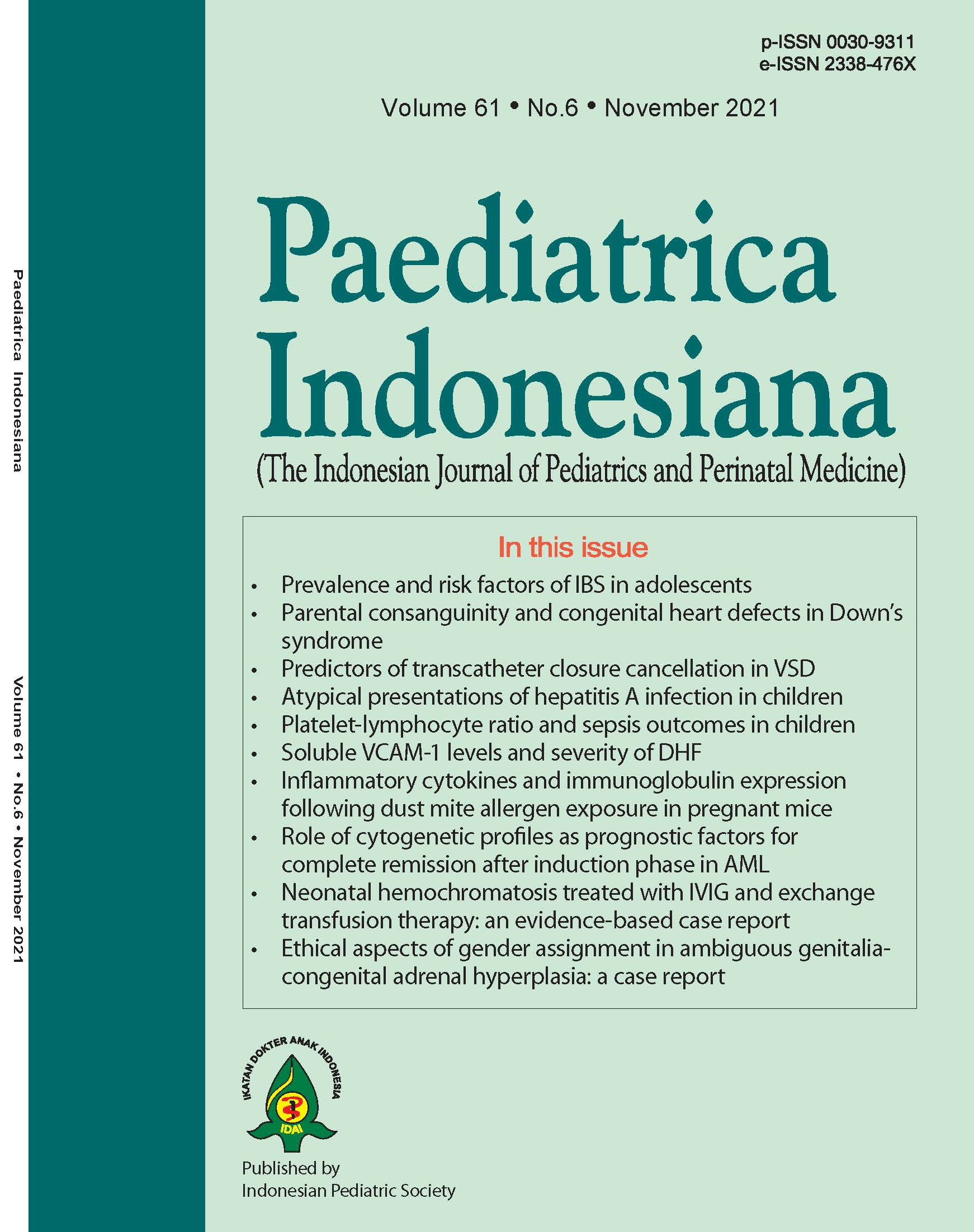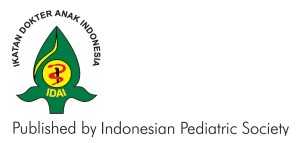Soluble vascular cell adhesion molecule-1 levels and severity of dengue hemorrhagic fever in children
Abstract
Background The clinical manifestations of dengue infection vary widely, ranging from asymptomatic to severe forms that can cause death. In severe infections, the expression of soluble vascular cell adhesion molecule-1 (sVCAM-1) in endothelial cells is reportedly excessive, causing endothelial cell gaps through VE-cadherin and plasma leakage, which is the basic mechanism for shock in dengue hemorrhagic fever (DHF).
Objective To determine the association between sVCAM-1 levels and severity of dengue hemorrhagic fever in children.
Methods This cross-sectional study was done in children with DHF at Dr. M. Djamil Hospital, Padang, West Sumatera. Subjects were diagnosed according to the 2011 WHO criteria and selected by consecutive sampling. They were grouped as DHF with or without shock. Examination of sVCAM-1 levels was done by ELISA method. Mann-Whitney test with a significance of P<0.05 was used for statistical analysis.
Results A total of 66 patients were collected from January 2018 to December 2019, but 2 patients were excluded. The 64 subjects who met the inclusion criteria consisted of 32 (50%) DHF without shock and 32 (50%) DHF with shock. Median sVCAM-1 was significantly higher in the DHF with shock group (840 ng/mL) than in DHF without shock group (598 ng/mL) (P<0.05).
Conclusion There was a significant association between higher sVCAM-1 levels and greater severity of dengue hemorrhagic fever in children.
References
2. Candra A. Demam berdarah dengue: epidemiologi, patogenesis, dan faktor risiko penularan. J Aspirator. 2010;2:110–9. doi: 10.22435/ASPIRATOR.V2I2.2951.
3. Gurugama P, Garg P, Perera J, Wijewickrama A, Seneviratne SL. Dengue viral infection. Indian J Dermatol. 2010;55:68–78. doi: 10.4103/0019-5154.60357.
4. Srikiatkhachorn A, Kelley JF. Endothelial cells in dengue hemorrhagic fever. Antiviral Res. 2014;109:160–70. doi: 10.1186/s12916-014-0147-9.
5. Kementerian Kesehatan Republik Indonesia. Profil Kesehatan Indonesia 2014. Yudianto, Budijanto D, Hardhana B, Soenardi TA, editors. Jakarta: Kementerian Kesehatan RI; 2015.
6. Ong SP, Ng ML, Chu JJH. Differential regulation of angiopoietin 1 and angiopoietin 2 during dengue virus infection of human umbilical vein endothelial cells: Implications for endothelial hyperpermeability. Med Microbiol Immunol. 2013;202:437–52. doi: 10.1007/s00430-013-0310-5
7. Wallez Y, Huber P. Endothelial adherens and tight junctions in vascular homeostasis, inflammation and angiogenesis. Biochim Biophys Acta - Biomembr. 2008;1778:794–809. doi: 10.1016/j.bbamem.2007.09.003
8. Vallance P, John L. Blood vessels and the endothelium. In: Warrell DA, Cox TM, Firth JD, editors. Oxford Textbook of Medicine. 5th ed. Oxford: Oxford University Press; 2015. p. 6–13.
9. Coombe D, Dye D. Feature, structure and classification of adhesion molecules: an overview. In: Preedy V, editor. Adhesion Molecules. New York: CRC Press; 2010. p. 1–20.
10. Ley K, Huo Y. VCAM-1 is critical in atherosclerosis. J Clin Invest. 2004;107:1209–10. doi: 10.1172/JCI13005.
11. Galley HF, Webster NR. Physiology of the endothelium. Br J Anaesth. 2004;93:105–13. doi: 10.1093/bja/aeh163.
12. Kluger. Vascular endothelial cell adhesion and signaling during leukocyte recruitment. Adv Dermatol. 2004;20:163–201. PMID: 15544200.
13. Dharma R, Hadinegoro S, Priatni I. Disfungsi endotel pada demam berdarah dengue. Makara Kesehat. 2006;10:17–23.
14. Hadinegoro S, Moedjito I, Chairulfatah A. Pedoman diagnosis dan tata laksana infeksi virus dengue pada anak. Edisi 1. Jakarta: Badan Penerbit Ikatan Dokter Anak Indonesia; 2014. p. 37-42.
15. Luplertlop N, Missé D, Bray D, Deleuze V, Gonzalez J-P, Leardkamolkarn V, et al. Dengue-virus-infected dendritic cells trigger vascular leakage through metalloproteinase overproduction. EMBO Rep. 2006;7:1176–81. doi: 10.1038/sj.embor.7400814
16. Kementerian Kesehatan Republik Indonesia. Pedoman pengendalian demam berdarah dengue di indonesia. Indonesia KKR, editor. Jakarta: Direktorat Jendral Pengendalian Penyakit dan Penyehatan Lingkungan; 2017. p.14
17. Pothapregada S, Kamalakannan B, Thulasingham M. Risk factors for shock in children with dengue fever. Vol. 19, Indian Journal of Critical Care Medicine. 2015. p. 661–4. doi: 10.4103/0972-5229.169340.
18. Pongpan S, Wisitwong A, Tawichasri C, Putumanond J. Prognostic indicators for dengue infection severity. Int J Clin Pediatr. 2013;2:12–8. doi: 10.4021/ijcp73w.
19. Tatura SNN, Daud D, Yusuf I, Wahyuni S, Bernadus JB. Association between interleukin-8 and severity of dengue shock syndrome in children. Paediatr Indones. 2016;56:79-83. doi: 10.14238/pi56.2.2016.79-83.
20. Zulkipli MS, Dahlui M, Jamil N, Peramalah D, Wai HVC, Bulgiba A, et al. The association between obesity and dengue severity among pediatric patients: a systematic review and meta-analysis. PLoS Negl Trop Dis. 2018;12:e006263. doi: 10.1371/journal.pntd.0006263.
21. Hariawan H. Kadar adiponektin pada subyek obes dengan maupun tanpa Resistensi Insulin The Adiponection levels in obese subjects with and without Insulin Resistance. J Kedokt Yars. 2010;18:21–8.
22. Linardi JI, Suryawan IWB, Widiasa AAM. The association between overweight and shock in children with dengue hemorrhagic fever at wangaya general hospital, bali, Indonesia. Intisari Sains Medis. 2021;12:19–22. doi: 10.15562/ism.v12i1.868.
23. Marón GM, Clará AW, Diddle JW, Pleités EB, Miller L, MacDonald G, et al. Association between nutritional status and severity of dengue infection in children in el salvador. Am J Trop Med Hyg. 2010;82:324–9. doi: 10.4269/ajtmh.2010.09-0365.
24. Tantracheewathorn T, Tantracheewathorn S. Risk factors of dengue shock syndrome in children. J Med Assoc Thai. 2007;90:272–7. PMID: 17375631.
25. Nagaram PP, Piduru P, Munagala VK, Matli VV. Clinical and laboratory profile and outcome of dengue cases among children attending a tertiary care hospital of South India. Int J Contemp Pediatr. 2017;4:1074–80. doi: 10.18203/2349-3291.ijcp20171731.
26. Jain A, Alam S, Shalini A. Paediatric risk of mortality III score to predict outcome in patients admitted to PICU with dengue fever. Int Arch BioMed Clin Res. 2018;4:80–3. doi: 10.21276/iabcr.2018.4.2.24.
27. Woon YL, Hor CP, Hussin N, Zakaria A, Goh PP, Cheah WK. A two-year review on epidemiology and clinical characteristics of dengue deaths in malaysia, 2013-2014. PLoS Negl Trop Dis. 2016;10:e0004575. doi: 10.1371/journal.pntd.0004575.
28. Huy NT, Van Giang T, Thuy DHD, Kikuchi M, Hien TT, Zamora J, et al. Factors associated with dengue shock syndrome: a systematic review and meta-analysis. PLoS Negl Trop Dis. 2013;7:e2412. doi: 10.1371/journal.pntd.0002412.
29. Ledika MA, Setiabudi D, Dhamayanti M. Association between clinical profiles and severe dengue infection in children in developing country. Am J Epidemiol Infect Dis. 2015;3:45–9. doi: 10.12691/ajeid-3-3-1.
30. Wahala WM, Silva AM. The human antibody response to dengue virus infection. Viruses. 2011;3:2374–95. doi: 10.3390/v3122374.
31. Ranjit S, Kissoon N. Dengue hemorrhagic fever and shock syndromes. Pediatr Crit Care Med. 2011;12:90–100. doi: 10.1097/PCC.0b013e3181e911a7.
32. Liao B, Tang Y, Hu F, Zhou W, Yao X, Hong W, et al. Serum levels of soluble vascular cell adhesion molecules may correlate with the severity of dengue virus-1 infection in adults. Emerg Microbes Infect. 2015;4:e24. doi: 10.1038/emi.2015.24.
33. Koraka P, Murgue B, Deparis X, Gorp ECM van, Setiati TE, Osterhaus ADME, et al. Elevation of soluble VCAM?1 plasma levels in children with acute dengue virus infection of varying severity. J Med Virol. 2004;72:445–50. doi: 10.1002/jmv.20007.
34. Ho JW, Poon RT, Tong CS, Fan ST. Clinical significance of serum vascular cell adhesion molecule-1 levels in patients with hepatocellular carcinoma. World J Gastroenterol. 2004;10:2014–8. doi: 10.3748/wjg.v10.i14.2014.
Copyright (c) 2021 Nolitriani Nolitriani

This work is licensed under a Creative Commons Attribution-NonCommercial-ShareAlike 4.0 International License.
Authors who publish with this journal agree to the following terms:
Authors retain copyright and grant the journal right of first publication with the work simultaneously licensed under a Creative Commons Attribution License that allows others to share the work with an acknowledgement of the work's authorship and initial publication in this journal.
Authors are able to enter into separate, additional contractual arrangements for the non-exclusive distribution of the journal's published version of the work (e.g., post it to an institutional repository or publish it in a book), with an acknowledgement of its initial publication in this journal.
Accepted 2021-11-22
Published 2021-11-22













